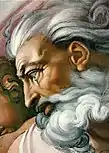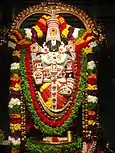神 (一神教)
在一神教中,神(英語:)被认为是至高无上的存在,是宇宙萬物的創造者,通常也是信仰的主要目标[1]。一神教中有關神的概念有全知(無所不知)、全能(無所不能)、全在(無所不在),是永恆且必然的存在。這些屬性可能是類比的,也可以以字面上來解讀。一般會認為神是無形體(非物质的)的[1][2][3]。神有形體(corporeality)或無形體(incorporeality)常和神的內蘊(在自然界之中)及超越性(在自然界以外)的概念有關。
| 有神論相關系列 |
| 神 |
|---|
有些宗教的神是沒有性別的,也有一些宗教(或是後來的翻譯)對神使用了有區分性別的詞語。例如猶太教對於神有文法上的性別,為了方便,使用像是 Him 或是 Father 的稱呼[4]。
有些宗教認為神是有位格的,有些則認為是無位格的。在有神论中,神是宇宙萬物的創造者及维持者。在自然神论中,神是創造者,但不是维持者。雖然上帝創造了宇宙和它存在的規則,但是在此之後上帝並不再對這個世界的發展產生影響。泛神论中的神就是宇宙本身,无神论中沒有神的存在和對其的信仰。不可知论則認為不確定神是否存在。一般也認為神是所有道德責任的源頭,也是最偉大的[1]。有關神的存在性,許多著名的哲學家都有相關的論述,有些支持神存在,有些則認為神不存在[5]。
一神教的信徒會用所信仰的宗教對神的稱呼來稱呼神,其中有些名字是和神的特質及屬性有關的文化概念。在古埃及的阿肯那頓改革,可能是有紀錄的最早的一神教,其中神的名字是阿頓(aten)[6],意思是唯一「真正」的至高者,也是宇宙的創造者[7]。在希伯來聖經及犹太教中,神的名字有埃洛希姆(Elohim), Adonai、四字神名(希伯來語:)及其他名字;雅威(Yahweh)及耶和華(Jehovah)是基督教所使用的名字,可能是將四字神名YHWH加上母音而得的。基督教的教義中有三位一體:神只有一位,不過有三個位格,分別是聖父、聖子、聖靈或聖神。在伊斯兰教中,會用安拉或真主來稱呼神,不過穆斯林也會用其他對神的稱呼。印度教中,有時會將梵視為是一元论概念下的神[8]。其他的宗教也有神的名字,例如巴哈伊信仰中的神[9]、锡克教中的Waheguru[10]、巴厘島印度教中的Sang Hyang Widhi Wasa[11]以及琐罗亚斯德教中的阿胡拉·馬茲達[12]。
有關神的許多不同的概念,以及彼此衝突的神的屬性、目地以及行動,帶來了像泛神論、泛自然神論[13]或长青哲学的發展,這些思想認為有一個根本性的神學真理,但每一個宗教都只有部份的理解,因此「其實上,全世界眾多廣大的宗教其實是在崇拜同一個神,不過是用許多不同、重疊的概念」[14]。
神的存在性
一神教中的神的存在性是一个广受关注的话题,从古至今,许多知名的哲学家、科学家对神的存在性提出过疑问或反对。迈蒙尼德、圣奥古斯丁、牛顿等人认为神是存在的,同时也有许多科学家、哲学家否认神的存在。近代的不可知论者的代表人物伯特兰·罗素,则相信上帝是否存在是无法证明的,但无法否认其它众人感知的存在,这涉及了哲学上“实存”的争议。
費爾巴哈认為:在各個方面神與人類本能的一般特性和需求是一致的,「若人類想要找出神的意涵,他就要在神(的意涵) 找出他自己」。「神就是人」,可以這樣說,「神是人類的內在本性向外的投射」。費爾巴哈提出唯物價值觀(materialism)的自然神論的觀點——這引導人們由另一個角度思考「神和人的關係」:是神創造了人還是人創造了神?
神的特征
信仰分布
截至2000年,全世界大约53%的人口信仰三大亞伯拉罕諸教中的一种(33%为基督宗教 ,20%为伊斯兰教,不到1%为犹太教),6%信仰佛教 ,13%信仰印度教,6%信仰中国传统宗教,7%信仰其他多种宗教,不到15%的人为无信仰者。大多数宗教信仰存在一神或多神。[19]
参考文献
- Richard Swinburne "God" in Ted Honderich. (ed)The Oxford Companion to Philosophy, Oxford University Press], 1995.
- David Bordwell (2002). Catechism of the Catholic Church, Continuum International Publishing ISBN 978-0-86012-324-8 p. 84
- . [30 December 2016]. (原始内容存档于3 March 2013).
- "G-d has no body, no genitalia, therefore the very idea that G-d is male or female is patently absurd. Although in the Talmudic part of the Torah and especially in Kabalah G-d is referred to under the name 'Sh'chinah' – which is feminine, this is only to accentuate the fact that all the creation and nature are actually in the receiving end in reference to the creator and as no part of the creation can perceive the creator outside of nature, it is adequate to refer to the divine presence in feminine form. We refer to G-d using masculine terms simply for convenience's sake, because Hebrew has no neutral gender; G-d is no more male than a table is." Judaism 101 (页面存档备份,存于). "The fact that we always refer to God as 'He' is also not meant to imply that the concept of sex or gender applies to God." Rabbi Aryeh Kaplan, The Aryeh Kaplan Reader, Mesorah Publications (1983), p. 144
- Platinga, Alvin. "God, Arguments for the Existence of", Routledge Encyclopedia of Philosophy, Routledge, 2000.
- Jan Assmann, Religion and Cultural Memory: Ten Studies, Stanford University Press 2005, p. 59
- M. Lichtheim, Ancient Egyptian Literature, Vol. 2, 1980, p. 96
- Pantheism: A Non-Theistic Concept of Deity – p. 136, Michael P. Levine – 2002
- A Feast for the Soul: Meditations on the Attributes of God : ... – p. x, Baháʾuʾlláh, Joyce Watanabe – 2006
- Philosophy and Faith of Sikhism – p. ix, Kartar Singh Duggal – 1988
- McDaniel, June (2013), A Modern Hindu Monotheism: Indonesian Hindus as ‘People of the Book’. The Journal of Hindu Studies, Oxford University Press, doi:10.1093/jhs/hit030
- The Intellectual Devotional: Revive Your Mind, Complete Your Education, and Roam confidently with the cultured class, David S. Kidder, Noah D. Oppenheim, p. 364
- Alan H. Dawe. . 2011: 48. ISBN 978-0-473-20114-2.
Pandeism: This is the belief that God created the universe, is now one with it, and so, is no longer a separate conscious entity. This is a combination of pantheism (God is identical to the universe) and deism (God created the universe and then withdrew Himself).
- Christianity and Other Religions, by John Hick and Brian Hebblethwaite. 1980. p. 178.
- Aquinas, Thomas. . Part 1, Question 3, Article 1. 1274 [2014-02-06]. (原始内容存档于2011-11-09).
- of Hippo, Augustine. . Book 7. ~397.
- Elaine H. Pagels "What Became of God the Mother? Conflicting Images of God in Early Christianity" (页面存档备份,存于) Signs, Vol. 2, No. 2 (Winter, 1976), pp. 293-303
- Coogan, Michael. . 1st. New York, Boston: Twelve. Hachette Book Group. October 2010: 175 [2011-05-05]. ISBN 978-0-446-54525-9.
humans are modeled on elohim, specifically in their sexual differences.
- National Geographic Family Reference Atlas of the World p. 49




